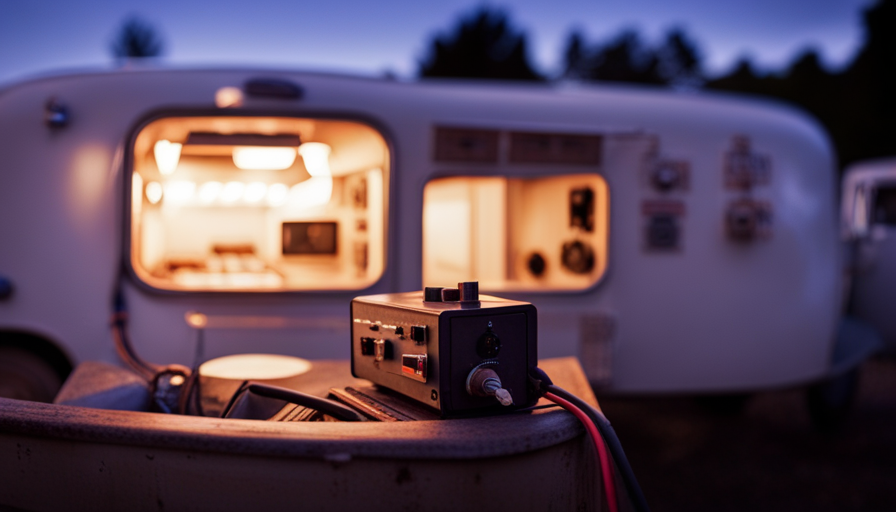Have you ever dealt with the aggravation of a faulty camper converter? Imagine this scenario: you’re enjoying a camping expedition, immersed in the beauty of nature, and out of the blue, your lights begin to fade, your gadgets won’t charge anymore, and a disturbing sound emerges. You think the camper converter might be to blame, but how do you confirm your suspicion? Worry not, dear fellow campers, because we’re here to show you how to pinpoint a problematic camper converter.
In this article, we will delve into the inner workings of a camper converter and explain its crucial role in powering your camper’s electrical system. We will then explore the common signs that indicate a faulty converter, such as dim or flickering lights, issues with charging devices, and strange noises or smells. To ensure accuracy, we will also provide detailed steps to test and troubleshoot your camper converter.
So, if you’re ready to tackle the mysteries of camper converter troubleshooting, read on! By the end of this article, you’ll be equipped with the knowledge to repair or replace your faulty converter and even prevent future issues through proper maintenance. Let’s get started!
Key Takeaways
- Dim or flickering lights, overheating, inconsistent charging, strange noises, and burning smell are signs of a bad camper converter.
- Promptly address dim or flickering lights to avoid further damage to the electrical system.
- Check power outlets, inspect charging cables, and monitor battery drainage to troubleshoot charging device issues.
- Strange noises or smells can indicate damaged wiring or overheating issues in the camper.
Understanding the Function of a Camper Converter
So, you’re wondering how to tell if your camper converter is bad, huh? Well, let me break it down for you by first explaining the function of a camper converter.
Camper converter troubleshooting is essential for maintaining the proper functioning of your camper’s electrical system. The converter is responsible for converting the 120-volt AC power from a campground hookup or generator into 12-volt DC power that can be used to charge the camper’s batteries and power the DC appliances and lights.
The importance of camper converter maintenance can’t be overstated. A well-maintained converter ensures that your camper’s batteries are charged efficiently and that all DC appliances and lights are working correctly. Without a functioning converter, you may experience issues such as dim lights, weak battery performance, or complete power failure.
Now that you understand the function and importance of a camper converter, let’s dive into the common signs of a bad camper converter.
Common Signs of a Bad Camper Converter
One surefire way to spot a faulty camper converter is by paying attention to common signs of its malfunction, such as frequent power outages that can leave you stranded in the middle of nowhere. Here are five key signs of a failing camper converter that can help you diagnose a faulty unit:
-
Dim or flickering lights: When your camper’s lights start to dim or flicker, it’s a clear indication that the converter isn’t providing a consistent power supply. This can be dangerous, especially when driving at night.
-
Overheating: If you notice that your camper converter is unusually hot to the touch, it could be a sign of an internal problem. Overheating can lead to further damage and potential electrical hazards.
-
Inconsistent charging: A faulty converter may not effectively charge your camper’s batteries, leading to decreased battery life and unreliable power supply. This can be frustrating and inconvenient during your camping trips.
-
Strange noises: Unusual buzzing, humming, or clicking sounds coming from the converter can indicate internal issues or loose connections. Ignoring these noises can result in more significant problems down the line.
-
Burning smell: A distinct burning odor coming from the converter is a serious cause for concern. It could be a sign of an electrical short or a component failure, which requires immediate attention.
By being aware of these signs, you can quickly identify a failing camper converter and take the necessary steps to address the issue.
Dim or Flickering Lights
If you notice your camper’s lights dimming or flickering, you’ll want to address the issue as soon as possible to avoid any potential dangers while driving at night. Dim or flickering lights are a common sign of a bad camper converter. The converter is responsible for converting the 120-volt AC power from your campground hookup into 12-volt DC power that your camper can use.
When the converter is malfunctioning, it can cause voltage fluctuations, leading to dim or flickering lights. There are a few possible reasons why your camper converter may be causing dim or flickering lights. One common issue is overheating problems. If the converter gets too hot, it can start to malfunction and cause voltage fluctuations. Another possible cause is a faulty converter that needs to be replaced.
In either case, it’s important to address the issue promptly to avoid any further damage to your camper’s electrical system. Dim or flickering lights can be a warning sign of larger issues with your camper’s electrical system, such as problems with charging devices. If left unaddressed, these issues can lead to more serious problems down the road. Therefore, it’s crucial to have a professional inspect and repair your camper converter if you notice any dim or flickering lights.
Issues with Charging Devices
Experiencing problems with your camper’s lights dimming or flickering? Don’t overlook the possibility of issues with your charging devices! Faulty power outlets or battery drainage can often be the culprits behind these frustrating problems.
Here are a few things to consider when troubleshooting your charging devices:
-
Check the power outlets: Make sure that the outlets you’re using to charge your devices are functioning properly. Faulty outlets can cause inconsistent power flow, resulting in dim or flickering lights. Use a voltage tester to ensure that the outlets are providing the correct voltage.
-
Inspect the charging cables: Damaged or worn-out charging cables can also cause issues with your camper’s lights. Check for any visible signs of wear, such as frayed wires or loose connections. If you notice any damage, replace the cables immediately.
-
Monitor battery drainage: Excessive battery drainage can put additional strain on your charging devices, causing them to perform poorly. Keep an eye on your camper’s battery levels and make sure they’re being properly maintained.
By addressing these potential issues, you can ensure that your charging devices are functioning optimally and prevent further problems with your camper’s electrical system.
Now, let’s move on to the next section about strange noises or smells.
Strange Noises or Smells
Take a moment to listen closely for any strange noises or detect any unusual smells in your camper, as they could indicate potential issues that need immediate attention. When it comes to your camper’s electrical system, damaged wiring or overheating issues can lead to serious problems. If you hear buzzing, crackling, or popping sounds coming from your converter, it could be a sign of damaged wiring. This can occur due to wear and tear, rodents chewing on the wires, or improper installation.
Additionally, if you notice a burning smell or the odor of melted plastic, it could be an indication of overheating issues. Overheating can occur when the converter is working harder than it should, which can lead to electrical malfunctions and even fires. If you experience any of these signs, it’s crucial to address the issue promptly to avoid further damage or potential safety hazards.
Moving on to the next section about inconsistent power output, it’s important to understand the potential causes and how to identify them.
Inconsistent Power Output
Unpredictable power fluctuations can leave you feeling frustrated and powerless in your camper. When your camper converter is bad, it can result in inconsistent power output, causing power surges and electrical fluctuations. Here are four signs that your camper converter may be the culprit behind these issues:
-
Voltage drops: If you notice that the voltage in your camper fluctuates between high and low levels, it could indicate a problem with the converter. This can lead to appliances not receiving enough power or even getting damaged.
-
Dimming lights: When the converter isn’t functioning properly, you may experience dimming or flickering lights. This happens because the converter fails to regulate the power supply, causing fluctuations in the voltage.
-
Overheating: A faulty converter can overheat due to excessive power usage or internal issues. This can lead to a loss in power output and potential damage to the converter itself.
-
Circuit breaker tripping: If the converter isn’t providing a consistent power supply, it can overload the circuit and cause the breaker to trip. This is a safety mechanism to prevent electrical damage.
If you’re experiencing any of these issues, it’s important to test the camper converter to confirm if it’s the cause of the problem.
Testing the Camper Converter
To determine the functionality of your camper converter, try running a voltage test to ensure a consistent power supply. This is an important step in camper converter troubleshooting and maintenance.
Start by turning off all power sources and disconnecting the camper from any external power connections.
Next, locate the converter in your camper, usually found near the electrical panel. Use a voltmeter to test the output voltage of the converter. The reading should be within the specified range, typically between 13.2 and 14.4 volts. If the voltage is too low or too high, it indicates a problem with the converter. In such cases, you may need to replace or repair the converter to restore proper functionality.
Additionally, check for any loose or corroded connections, as they can also cause power inconsistencies.
By regularly testing the camper converter and performing necessary maintenance, you can ensure a reliable power supply for your camper.
Now, let’s move on to the troubleshooting steps to address any issues we may find.
Troubleshooting Steps
After testing the camper converter, if it’s determined that it’s not functioning properly, there are several troubleshooting tips to follow in order to identify the potential causes of the problem.
Firstly, it’s important to check the power source to ensure that it’s providing the correct voltage and that there aren’t any loose connections.
Additionally, inspecting the fuses and circuit breakers is crucial, as a blown fuse or tripped circuit breaker can cause the converter to malfunction.
Another potential cause could be a faulty wiring connection, so it’s essential to inspect all wiring and connections for any signs of damage or corrosion.
Furthermore, testing the converter’s output voltage using a multimeter can help determine if it’s producing the correct amount of power.
If none of these troubleshooting steps resolve the issue, it may be necessary to consider repairing or replacing the bad camper converter. This will be covered in detail in the subsequent section.
Repairing or Replacing a Bad Camper Converter
If you’re faced with a malfunctioning camper converter, you’ll need to consider either repairing or replacing it to ensure your power needs are met on your camping adventures. When deciding between repair and replacement options, it’s important to weigh the cost, time, and expertise required for each choice.
Here are some troubleshooting steps to help you make an informed decision:
-
Evaluate the extent of the damage: Determine if the issue is minor and can be fixed with simple repairs or if it requires a complete replacement.
-
Consider the age and condition of the converter: Older models may be more prone to breakdowns, making replacement a more practical choice.
-
Consult a professional: Seek advice from an expert who can assess the problem and provide guidance on the best course of action.
-
Compare costs: Calculate the expenses involved in repairing versus replacing the converter, including parts, labor, and potential future breakdowns.
-
Assess your DIY skills: If you have the knowledge and tools, you may be able to repair the converter yourself, saving money on professional services.
Once you’ve made your decision, it’s important to ensure you perform preventive maintenance on your camper converter to avoid future issues.
[Transition sentence to next section].Preventive Maintenance Tips for Your Camper Converter
Now that we’ve discussed how to repair or replace a bad camper converter, let’s shift our focus to the importance of regular maintenance for your camper converter.
Proper maintenance is crucial to ensure the longevity and optimal performance of your converter. Regular maintenance not only helps prevent potential issues but also extends the lifespan of your camper converter. It’s recommended to follow the manufacturer’s guidelines for maintenance, which may include routine inspections, cleaning, and testing of the converter.
When choosing a camper converter, there are several key factors to consider. First and foremost, you should determine the power requirements of your camper. This’ll help you select a converter with the appropriate voltage and current capabilities. Additionally, consider the size and weight of the converter, as it should be compatible with your camper’s space limitations.
Another important factor to consider is the efficiency of the converter. Look for converters that have high conversion efficiency, as this’ll minimize energy loss and optimize power output.
Regular maintenance is essential for your camper converter to ensure its reliable performance. When choosing a converter, carefully consider the power requirements, size, weight, and efficiency. By taking these factors into account, you can select a converter that meets your camper’s needs and enjoy worry-free camping experiences.
Frequently Asked Questions
How much does it cost to repair or replace a bad camper converter?
When it comes to repairing or replacing a bad camper converter, the cost can vary depending on several factors. A cost comparison is essential to make an informed decision.
Common issues with camper converters include overheating, power surges, and faulty wiring. To accurately determine the cost, it’s crucial to diagnose the specific problem and evaluate the extent of the damage.
Professional assistance is recommended for a technical, precise, and detailed analysis.
Are there any DIY troubleshooting steps I can try before calling a professional?
Before calling a professional, there are several troubleshooting steps and DIY solutions you can try to determine if your camper converter is bad.
Start by checking the power source and ensuring it’s functioning properly.
Next, inspect the wiring connections for any loose or damaged wires.
Test the voltage output of the converter using a multimeter. If the voltage is significantly lower than it should be, this may indicate a faulty converter.
Additionally, you can try resetting the converter or cleaning any dust or debris that may be affecting its performance.
Can a bad camper converter cause damage to my RV’s electrical system?
Yes, a bad camper converter can cause damage to your RV’s electrical system. Signs of a failing camper converter include dimming or flickering lights, appliances not working properly, and batteries not charging fully. A faulty converter can result in inconsistent power supply, leading to voltage spikes or drops that can harm sensitive electronics and appliances. It’s crucial to address any camper converter troubleshooting promptly to prevent further damage to your RV’s electrical system.
Is it possible to upgrade my camper converter to a more efficient model?
Yes, it’s possible to upgrade your camper converter to a more efficient model. While some may argue that the cost of upgrading outweighs the benefits, investing in a more efficient converter can actually save you money in the long run.
A more efficient model will convert power more effectively, reducing energy waste and potentially extending the life of your RV’s electrical system. Additionally, a more efficient converter can provide a more stable power supply, which is crucial for running sensitive electronics in your camper.
Are there any specific preventive maintenance tasks I should perform regularly to keep my camper converter in good condition?
To ensure the camper converter remains in optimal condition, it’s crucial to perform regular preventive maintenance tasks.
These tasks include inspecting the converter for any signs of damage or wear, cleaning the unit to prevent dirt or debris buildup, and checking the connections for any loose or corroded wires.
Additionally, monitoring the converter’s performance and addressing common issues like overheating or voltage fluctuations promptly will help maintain its functionality and extend its lifespan.
Can a Bad Camper Converter Lead to Water Damage?
A bad camper converter can indeed result in water damage, leading to costly repairs. If the converter fails to regulate the flow of electricity properly, it can cause electrical issues that may result in leaks. Such leaks can go unnoticed if not examined closely. These telltale signs of camper water damage, such as soft spots on the floor or walls, must not be ignored as they can worsen over time and compromise the structural integrity of the camper.
What Are the Signs of a Bad Camper Converter in a 4 Seasons Camper?
When it comes to identifying all season campers, a bad camper converter can be a major issue. Signs of a faulty converter include flickering lights, inconsistent power output, and strange odors. It’s important to address these signs promptly to ensure a comfortable and safe camping experience in all seasons.
Conclusion
In conclusion, taking care of your camper converter is crucial for a smooth and enjoyable camping experience. By understanding the function of the converter and recognizing common signs of a bad one, you can troubleshoot and address any issues that may arise.
Remember to regularly test and maintain your converter to prevent future problems. Just imagine the frustration of being in the middle of nowhere, surrounded by darkness, with no way to charge your devices or illuminate your campsite. Don’t let that happen to you – take care of your camper converter!











